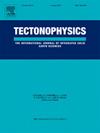Revisiting the dip-slip rate of the North Tehran Fault (Northern Iran) through studying the faulted materials and geomorphic markers
IF 2.7
3区 地球科学
Q2 GEOCHEMISTRY & GEOPHYSICS
引用次数: 0
Abstract
The North Tehran Fault (NTF), located south of the Central Alborz Mountains, crosses north of the megacity of Tehran. The NTF is the principal active fault in Tehran, playing an essential role in the risk potential for the near ten million inhabitants of the capital city. Despite this risk, our knowledge about its slip rate is limited to two contradictory quantifications for the western segment of the fault. Slip rates remain unquantified towards the north and east, where it forms a transpressional duplex structure with the Mosha Fault. In this study, we combine detailed fieldwork on the previously documented outcrops of the NTF, including faulted colluvial and alluvial units in the west and uplifted remnants of the pediment surface in the east of the fault. We present new luminescence ages to temporally constrain the fault activity in the Middle-Late Pleistocene in selected sites. Our study in the western NTF reports a cumulative dip-slip rate of 0.56 ± 0.04 mm a−1 for the Kan area and a minimum slip rate of 0.28 ± 0.02 mm a−1 for the Hesarak area outcrops. On the hanging wall of the eastern NTF, a dated pediment surface has risen 579 m relative to the present base level of the Kond River in the footwall. Our analyses suggest that 299 m of such differential movement is thrust-related uplift, which indicates an uplift rate of 1.00 ± 0.12 mm a−1. The dip-slip and shortening rates for the NTF at the Latyan Basin amounts to 1.39 ± 0.17 mm a−1 and 0.97 ± 0.12 mm a−1, respectively.
通过对断层物质和地貌标志的研究,重新审视伊朗北部北德黑兰断层的倾滑速率
北德黑兰断层(NTF)位于中部阿尔博尔斯山脉以南,穿过德黑兰大城市的北部。NTF是德黑兰的主要活动断层,对首都近1000万居民的潜在风险起着至关重要的作用。尽管存在这种风险,但我们对断层西段滑动率的了解仅限于两个相互矛盾的量化。在北部和东部,它与莫沙断裂形成了一个逆挤压复式构造,滑动速率仍然无法量化。在这项研究中,我们结合了对NTF先前记录的露头的详细野外工作,包括断层西部的断层崩落和冲积单元以及断层东部凸起的山形面残余物。我们提出了新的发光年龄,以在时间上限制中晚更新世在选定地点的断层活动。我们在NTF西部的研究报告显示,Kan地区的累积滑移速率为0.56±0.04 mm a−1,Hesarak地区露头的最小滑移速率为0.28±0.02 mm a−1。在NTF东部的上壁上,一个古老的山形墙表面相对于目前下盘的孔河基准面上升了579米。我们的分析表明299 m的这种差异运动是与逆冲有关的隆升,表明隆升速率为1.00±0.12 mm a−1。Latyan盆地NTF的倾滑速率为1.39±0.17 mm a−1,缩短速率为0.97±0.12 mm a−1。
本文章由计算机程序翻译,如有差异,请以英文原文为准。
求助全文
约1分钟内获得全文
求助全文
来源期刊

Tectonophysics
地学-地球化学与地球物理
CiteScore
4.90
自引率
6.90%
发文量
300
审稿时长
6 months
期刊介绍:
The prime focus of Tectonophysics will be high-impact original research and reviews in the fields of kinematics, structure, composition, and dynamics of the solid arth at all scales. Tectonophysics particularly encourages submission of papers based on the integration of a multitude of geophysical, geological, geochemical, geodynamic, and geotectonic methods
 求助内容:
求助内容: 应助结果提醒方式:
应助结果提醒方式:


